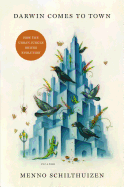
"Never before in the history of our planet," writes research scientist Menno Schilthuizen, "has a single life form been so dominant." Here he refers to humans, and throughout his beautifully researched and immensely engaging Darwin Comes to Town, he explores the surprising ways in which city development has shaped the natural world, right down to its DNA.
Among the highlights is the story of Manchester's peppered moth, which first emerged in nature as a pale, white-winged insect. By the middle of the Industrial Revolution, writes Schilthuizen, the moth's wings had evolved to coal black. The reason? To better blend in with the soot produced by the city's factories. The dark-winged moths were less visible to bird attacks than their white-winged siblings, so natural selection ultimately favored the former.
The stories captured here are not only fascinating to read; they are also evidence that evolution is happening at an extraordinarily fast pace. Indeed, it is something many of us will witness in our own lifetimes, says Schilthuizen, if only we care to look.
The author of three previous books, including Nature's Nether Regions, Schilthuizen largely avoids taking an ethical stance on our role in driving evolution. But he does insist that our role can no longer be ignored: "[We] have become fully integrated with everything that goes on this planet." Deeply informed by science but written for the layperson, Darwin Comes to Town is a hopeful reminder that nature can survive all kinds of destructive agents--even humans. --Amy Brady, freelance writer and editor

